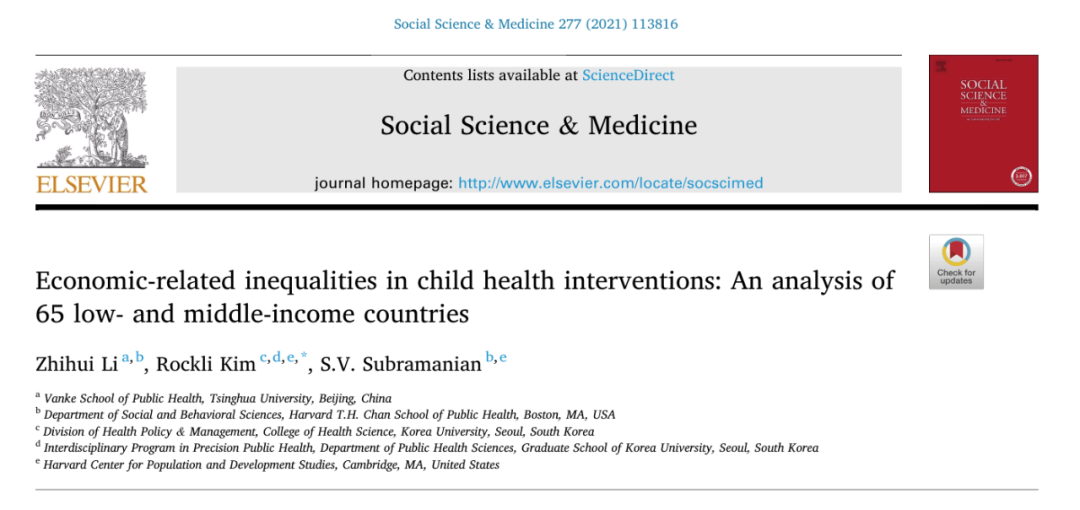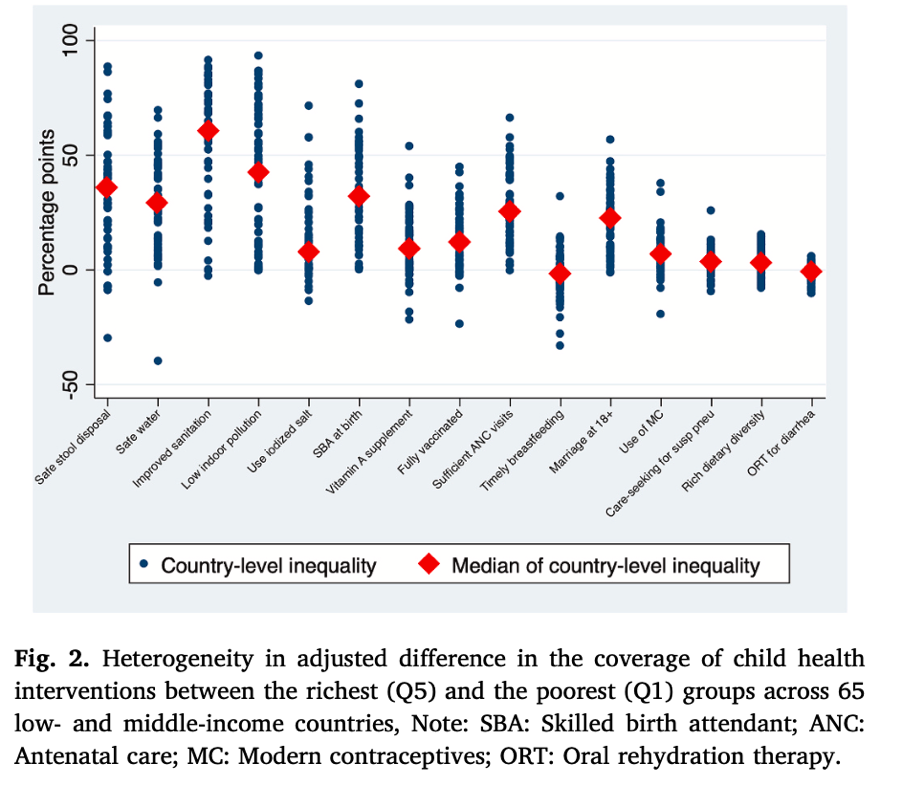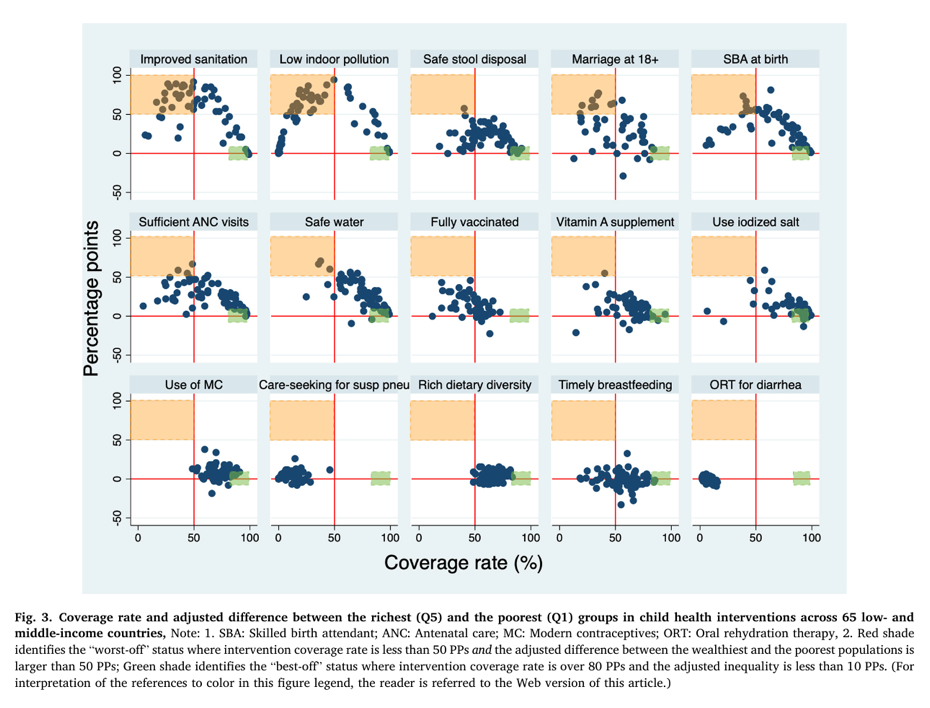联合国可持续发展目标(SDG)明确提出世界各国要在2030年将新生儿死亡率降低至12‰以及5岁以下儿童死亡率降至25‰或以下。然而每天全球仍有约17,000名5岁以下儿童死亡,超过五分之一的儿童营养不良[1][2]。就目前发展趋势来看,全球有47个国家(绝大多数为撒哈拉以南的贫困国家)将很难实现这一目标,该现象也印证了各国之间在儿童健康的不平等状况[3]。
除此之外,许多国家内部的不平等也日益凸显:研究显示,印度最贫困的20%人群中5岁以下儿童死亡率是最富有的20%人群的三倍之多[4]。许多针对儿童健康的干预措施,如住院分娩、由熟练的助产士接生以及使用现代避孕药具等,都不成比例地集中在较富裕的人口中。因此,SDG明确指出要从全球、国家和国家以下各级的层次减少不平等。而要为最边缘化和最弱势的儿童群体制定健康干预的策略,量化儿童健康干预措施中经济不平等的状况并对其进行更系统的监测是至关重要的。
近日,清华大学万科公共卫生与健康学院助理教授李志徽教授及其团队在《社会科学与医学》(Social Science & Medicine)上合作发表题为“儿童健康干预措施中的经济不平等:基于65个中低收入国家的分析“(Economic-related inequalitiesin child health interventions: An analysis of 65 low-and middle-incomecountries)的文章。

本研究基于DHS数据库2005年至2018年来自65个中低收入国家的876,209位5岁以下儿童的数据。本文从营养、行为健康、家庭环境和孕产妇四个方面选取了15项针对儿童健康的重要干预措施,并对这些儿童干预措施中的经济不平等进行分析,本文采用了两种计算方法:1)最富有和最贫穷群体之间的差异;2)集中度指数(concentration index)。
在汇总所有65个中低收入国家的数据后,结果指出除及时母乳喂养(出生后一小时)和治疗腹泻的口服补液疗法(ORT)两个干预措施, 其他所有儿童健康干预措施的覆盖率在最富有和最贫穷群体之间均存在着显著差异 (Figure1)。进一步地,本文分析了各个国家不平等状态的异质性,结果显示各国之间的不平等状态存在很大差异,其中与家庭环境和孕产妇相关的干预措施最为显著。例如,在塔吉克斯坦洁净的卫生环境(improved sanitation)的覆盖率在最富有人群与最贫穷的人群之间相差无几,而在柬埔寨的贫富人群的覆盖率相差91个百分点。另外,本文发现各个国家儿童营养和行为健康相关的干预措施的贫富差距较小(Figure2):对于治疗腹泻的口服补液疗法(ORT)、及时母乳喂养和饮食多样性这三个干预措施,只有少数国家的贫富差异大于20个百分点,其中许多是负数。

本文进一步研究了儿童健康干预措施的总体覆盖率是否与不平等的程度存在系统性关联(Figure 3)。结果显示所有家庭环境方面的干预措施以及大多数与孕产妇相关的干预措施,其覆盖率和不平等的程度呈现倒U形的关系。即当干预措施的覆盖率从较低的水平开始增加时,不平等的程度也开始加剧;直到覆盖率达到一个拐点,不平等的程度才开始下降,贫富差异开始缩小。对于家庭环境干预和孕产妇干预来说,在一个国家走向全面覆盖的过程中,首先受益的是较富裕的群体,达到一定的覆盖水平后,覆盖率在穷人群体中逐渐上升,公平性也会得到改善。

本文使用来自65个中低收入国家的数据来评估儿童健康干预措施中的经济不平等,以及其在各国的异质性。结果表明:第一,除了使用口服液治疗腹泻以及及时母乳喂养外,所有干预措施都存在不平等现象,其中家庭环境和孕产妇相关干预措施的不平等现象最为严重。第二,尽管各国之间存在很大的异质性,但大多数国家在家庭环境干预方面的不平等现象始终很严重(如改善环境卫生、减少室内污染和安全粪便处理)。第三,对于所有家庭环境干预措施和大多数孕产妇干预措施来说,覆盖率和不平等程度之间的关系呈倒U型曲线。也就是说,当干预措施的覆盖率开始上升时,首先受益的是较富裕的人群,直到达到一定的覆盖水平后,覆盖率在贫穷人群中才会逐渐上升。因此,要弥合国家内和国家间的健康不平等,定期监测儿童健康干预措施的不平等状况有着重大的意义。
Toachieve Sustainable Development Goal targets related to child health andwell-being, it is important to quantify inequalities in the essential childhealth interventions. We used the latest available Demographic and HealthSurveys from 65 low-income and middle-income countries between 2005 and 2018.We examined economic-related inequalities in 15 essential child healthinterventions spanning across four domains: nutrition, behavioral health,household environment, and maternal factors. In the pooled analysis, weobserved significant inequalities in all child health interventions, except inthe use of oral rehydration therapy (ORT) for child diarrhea. The interventionswith the largest adjusted difference between the richest (Q5) and the poorest(Q1) groups were in household environment domain: improved sanitation at 55.6percentage points [PPs] (95% confidence interval [CI]: 54.7, 56.6), low indoorpollution at 43.5 PPs (95% CI: 41.4, 45.9), and safe stool disposal at 39.8 PPs(95% CI: 38.7, 41.0). In 35 countries, the adjusted difference between Q5 andQ1 groups in improved sanitation was found to be larger than 50 PPs. At thesame time, country-specific analyses revealed substantial heterogeneity in theextent of inequalities in child health interventions. An inverted-U shape curvewas identified between the mean intervention coverage rate and the magnitude ofinequalities for household environmental and maternal interventions. Thissuggests an initial exacerbation of inequality in child health interventions asthe coverage increases until it reaches an inflection point at which inequalitybegins to decline even as the coverage continues to improve. Our findings callfor more systematic monitoring of economic-related inequalities in child healthinterventions to develop equity-oriented policies and programmes in globalhealth.
Keywords:Child health intervention;Inequality;Heterogeneity;Equity-oriented;Sustainable development goal

教授简介
李志徽
清华大学万科公共卫生与健康学院助理教授,博士,博士生导师。于2019年在哈佛大学公共卫生学院获得博士学位。主要研究领域包括:国际卫生治理与国际卫生援助的模式及有效性;社会经济和行为因素对人类健康的影响;母婴、青少年及生殖健康的决定因素;新冠肺炎疫情下的中国国际卫生援助策略。
【参考文献】
[1] Requejo, J.H., Bhutta, Z.A., 2015. The post-2015 agenda: staying the course in maternal and child survival. Arch. Dis. Child. 100 (Suppl 1), S76–S81.
[2] UNICEF. Malnutrition in Children [Internet]. [cited 2019 Jun 24]. Available from:
https://data.unicef.org/topic/nutrition/malnutrition/.
[3] Coll-Seck, A., Clark, H., Bahl, R., Peterson, S., Costello, A., Lucas, T., 2019. Framing an agenda for children thriving in the SDG era: a WHO–UNICEF–Lancet commission on child health and wellbeing. Lancet 393 (10167), 109–112.
[4] Chao F, You D, Pedersen J, Hug L, Alkema L. National and regional under-5 mortality rate by economic status for low-income and middle-income countries: a systematic assessment. The Lancet Global Health. 2018 May 1;6(5):e535-47.